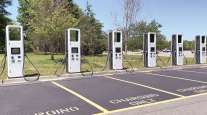Staff Reporter
Minnesotans Weigh In on Vehicle Electrification Priorities, Barriers

[Stay on top of transportation news: Get TTNews in your inbox.]
Electric vehicle charging opportunities should be prioritized as a strategy as Minnesota embraces transportation electrification, according to participants of a public engagement session held May 17.
The session, which focused on electric delivery and freight trucks, was hosted by the Minnesota Department of Transportation and facilitated by Great Plains Institute, an organization dedicated to crafting nonpartisan energy solutions. During the session, participants were presented with poll-based response questions.
Light-duty vehicle access and availability ranked No. 2 in terms of strategy prioritization, while medium- and heavy-duty access and availability ranked No. 3. These choices were followed by technology innovation and education and outreach. Equity and environmental justice ranked sixth.

Bocklund
Katelyn Bocklund, program manager at Great Plains Institute, said adequate charging infrastructure is a commonly cited concern for light- and heavy-vehicle operators. She suggested shorthaul trucking may serve as a better sector than longhaul operations for the initial pursuit fleet electrification.
“These vehicles that are driving 1,000-2,000 miles a day, those are likely not the best cases to electrify right now just because the technology isn’t there,” Bocklund said. “But over time, as we get more charging stations deployed and as it takes less time to charge during the day, we might see more of those vehicles electrify. If the fleet isn’t going thousands of miles every day and it’s returning to a home base every night and can charge overnight, those might be great cases to electrify.”
The event was the first in a series of public engagement sessions designed to hear from constituents about how EVs fit into the transportation needs of communities. MnDOT is planning to host six virtual engagement sessions, the last of which is scheduled for May 26.

Minnesota Department of Transportation
In terms of outreach and education for medium- and heavy-duty vehicles, participants supported developing and promoting best practices for siting charging stations at commercial buildings and parking lots. They also supported conducting outreach to fleet managers and identifying strategies to facilitate fleet electrification.
In a 2019 document titled “Accelerating Electric Vehicle Adoption: A Vision for Minnesota,” MnDOT outlined a goal of powering 20% of the light-duty cars in the state with electricity by 2030. The document also notes EVs can save money for heavy-duty fleet owners because of lower fueling and maintenance costs.
“One of the reasons we’re focusing today on trucks and buses and freight is that heavy-duty trucks, medium-duty trucks and light-duty trucks combined are nearly 70% of total greenhouse gas emissions from the transportation sector within Minnesota,” said Tim Sexton, MnDOT chief sustainability officer. “They’re largely what we would consider surface transportation or vehicles operating on Minnesota roadways.”

Minnesota Department of Transportation
Cost, lack of charging infrastructure and range were identified by participants as leading barriers to EV adoption.
Bocklund said there isn’t a straightforward answer in terms of balancing the costs of ownership between electric and diesel vehicles. There are many factors contributing to the total cost of vehicle ownership, including those associated with acquisition, maintenance, licensing and taxes.
She also noted the upfront purchase price of an electric vehicle can be two or three times as much as a comparable diesel engine vehicle.
“But when you consider all of these other costs and that you’re able to save in maintenance a lot of the time, [and] you’ll be saving in fueling and incentives as well,” Bocklund said, “it often does turn in favor to electric vehicles, even with these larger vehicles.”
Want more news? Listen to today's daily briefing below or go here for more info:




